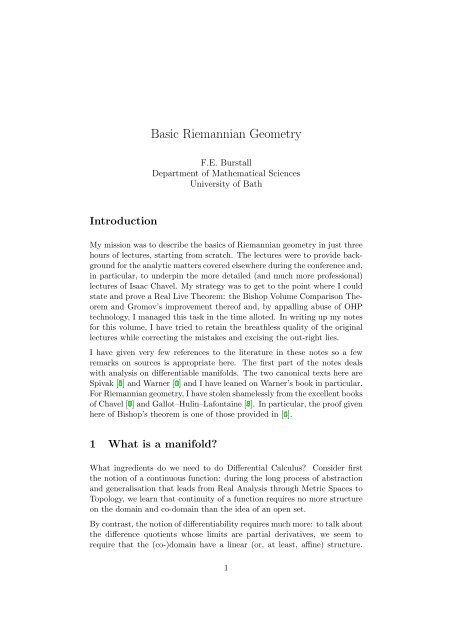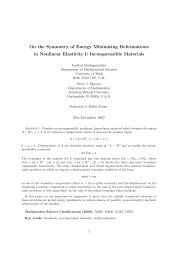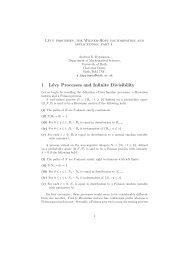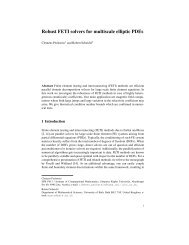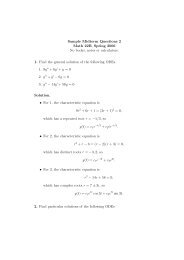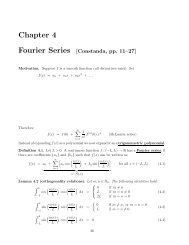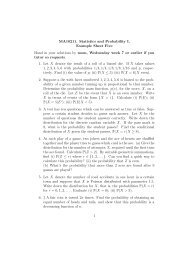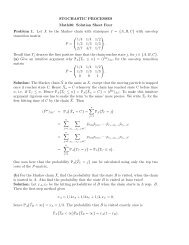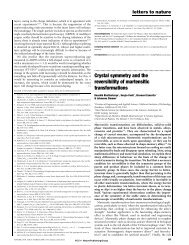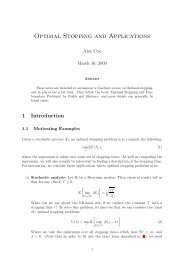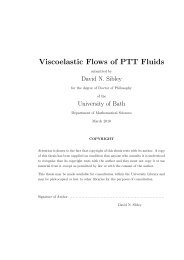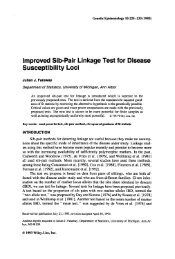Basic Riemannian Geometry - Department of Mathematical ...
Basic Riemannian Geometry - Department of Mathematical ...
Basic Riemannian Geometry - Department of Mathematical ...
Create successful ePaper yourself
Turn your PDF publications into a flip-book with our unique Google optimized e-Paper software.
4. An open subset <strong>of</strong> a manifold is a manifold in its own right with charts(U α ∩ U, x α | Uα ∩U).1.1.2 Functions and mapsA continuous function f : M → R is C r if each f ◦ x −1αC r function <strong>of</strong> the open set x α (U α ) ⊂ R n .We denote the vector space <strong>of</strong> all such functions by C r (M).Example. Any coordinate function x i : U α → R is C r on U α .: x α (U α ) → R is aExercise. The restriction <strong>of</strong> any C r function on R n+1 to the sphere S n isC r on S n .In the same way, a continuous map φ : M → N <strong>of</strong> C r manifolds is C r if,for all charts (U, x), (V, y) <strong>of</strong> M and N respectively, y ◦ φ ◦ x −1 is C r on itsdomain <strong>of</strong> definition.A slicker formulation 2 is that h ◦ φ ∈ C r (M), for all h ∈ C r (M).At this point, having made all the definitions, we shall stop pretending tobe anything other than Differential Geometers and henceforth take r = ∞.1.2 Tangent vectors and derivativesWe now know what functions on a manifold are and it is our task to differentiatethem. This requires some less than intuitive definitions so let usstep back and remind ourselves <strong>of</strong> what differentiation involves.Let f : Ω ⊂ R n → R and contemplate the derivative <strong>of</strong> f at some x ∈ Ω.This is a linear map df x : R n → R. However, it is better for us to take adual point <strong>of</strong> view and think <strong>of</strong> v ∈ R n is a linear map v : C ∞ (M) → R byThe Leibniz rule gives usvf def = df x (v).v(fg) = f(x)v(g) + v(f)g(x). (1.1)Fact. Any linear v : C ∞ (Ω) → R satisfying (1.1) arises this way.Now let M be a manifold. The preceding analysis may give some motivationto the following2 It requires a little machinery, in the shape <strong>of</strong> bump functions, to see that this is anequivalent formulation.3
Definition. A tangent vector at m ∈ M is a linear map ξ : C ∞ (M) → Rsuch thatfor all f, g ∈ C ∞ (M).ξ(fg) = f(m)ξ(g) + ξ(f)g(m)Denote by M m the vector space <strong>of</strong> all tangent vectors at m.Here are some examples1. For γ : I → M a (smooth) path with γ(t) = m, define γ ′ (t) ∈ M m byγ ′ (t)f = (f ◦ γ) ′ (t).Fact. All ξ ∈ M m are <strong>of</strong> the form γ ′ (t) for some path γ.2. Let (U, x) be a chart with coordinates x 1 , . . . , x n and x(m) = p ∈ R n .Define ∂ i|m ∈ M m by∂ i|m f = ∂(f ◦ ∣ x−1 ) ∣∣∣p∂x iFact. ∂ 1|m , . . . , ∂ n|m is a basis for M m .3. For p ∈ U ⊂ R n open, we know that U p is canonically isomorphic toR n viafor v ∈ R n .vf = df p (v)4. Let M = f −1 {c} be a regular level set <strong>of</strong> f : Ω ⊂ R n → R. One canshow that M m is a linear subspace <strong>of</strong> Ω m∼ = R n . Indeed, under thisidentification,M m = {v ∈ R n : v ⊥ ∇f m }.Now that we have got our hands on tangent vectors, the definition <strong>of</strong> thederivative <strong>of</strong> a function as a linear map on tangent vectors is almost tautological:Definition. For f ∈ C ∞ (M), the derivative df m : M m → R <strong>of</strong> f at m ∈ Mis defined bydf m (ξ) = ξf.4
We note:1. Each df m is a linear map and the Leibniz Rule holds:d(fg) m = g(m)df m + f(m)dg m .2. By construction, this definition coincides with the usual one when Mis an open subset <strong>of</strong> R n .Exercise. If f is a constant map on a manifold M, show that each df m = 0.The same circle <strong>of</strong> ideas enable us to differentiate maps between manifolds:Definition. For φ : M → N a smooth map <strong>of</strong> manifolds, the tangent mapdφ m : M m → N φ(m) at m ∈ M is the linear map defined byfor ξ ∈ M m and f ∈ C ∞ (N).dφ m (ξ)f = ξ(f ◦ φ),Exercise. Prove the chain rule: for φ : M → N and ψ : N → Z andm ∈ M,d(ψ ◦ φ) m = dψ φ(m) ◦ dφ m .Exercise. View R as a manifold (with a single chart!) and let f : M → R.We now have two competing definitions <strong>of</strong> df m . Show that they coincide.The tangent bundle <strong>of</strong> M is the disjoint union <strong>of</strong> the tangent spaces:T M = ∐M m .m∈M1.3 Vector fieldsDefinition. A vector field is a linear map X : C ∞ (M) → C ∞ (M) suchthatX(fg) = f(Xg) + g(Xf).Let Γ(T M) denote the vector space <strong>of</strong> all vector fields on M.We can view a vector field as a map X : M → T M with X(m) ∈ M m :indeed, we haveX |m ∈ M p5
whereX |m f = (Xf)(m).In fact, vector fields can be shown to be exactly those maps X : M → T Mwith X(m) ∈ M m which satisfy the additional smoothness constraint thatfor each f ∈ C ∞ (M), the function m ↦→ X(m)f is also C ∞ .The Lie bracket <strong>of</strong> X, Y ∈ Γ(T M) is [X, Y ] : C ∞ (M) → C ∞ (M) given by[X, Y ]f = X(Y f) − Y (Xf).The point <strong>of</strong> this definition is contained in the followingExercise. Show that [X, Y ] ∈ Γ(T M) also.The Lie bracket is interesting for several reasons. Firstly it equips Γ(T M)with the structure <strong>of</strong> a Lie algebra; secondly, it, and operators derived fromit, are the only differential operators that can be defined on an arbitrarymanifold without imposing additional structures such as special coordinates,a <strong>Riemannian</strong> metric, a complex structure or a symplectic form.There is an extension <strong>of</strong> the notion <strong>of</strong> vector field that we shall need lateron:Definition. Let φ : M → N be a map. A vector field along φ is a mapX : M → T N withX(m) ∈ N φ(m) ,for all m ∈ M, which additionally satisfies a smoothness assumption thatwe shall gloss over.Denote by Γ(φ −1 T N) the vector space <strong>of</strong> all vector fields along φ.Here are some examples:1. If c : I → N is a smooth path then c ′ ∈ Γ(φ −1 T N).2. More generally, for φ : M → N and X ∈ Γ(T M), dφ(X) ∈ Γ(φ −1 T N).Here, <strong>of</strong> course,dφ(X)(m) = dφ m (X |m ).3. For Y ∈ Γ(T N), Y ◦ φ ∈ Γ(φ −1 T N).6
1.4 ConnectionsWe would like to differentiate vector fields but as they take values in differentvector spaces at different points, it is not so clear how to make differencequotients and so derivatives. What is needed is some extra structure: a connectionwhich should be thought <strong>of</strong> as a “directional derivative” for vectorfields.Definition. A connection on T M is a bilinear mapT M × Γ(T M) → T M(ξ, X) ↦→ ∇ ξ Xsuch that, for ξ ∈ M m , X, Y ∈ Γ(T M) and f ∈ C ∞ (M),1. ∇ ξ X ∈ M m ;2. ∇ ξ (fX) = (ξf)X |m + f(m)∇ ξ X;3. ∇ X Y ∈ Γ(T M).A connection on T M comes with some additional baggage in the shape <strong>of</strong>two multilinear maps:given byT m : M m × M m → M mR m : M m × M m × M m → M mT m (ξ, η) = ∇ ξ Y − ∇ η X − [X, Y ] |mR m (ξ, η)ζ = ∇ η ∇ X Z − ∇ ξ ∇ Y Z − ∇ [Y,X]|mwhere X, Y , Z ∈ Γ(T M) with X |m = ξ, Y |m = η and Z |m = ζ.T m and R m are, respectively, the torsion and curvature at m <strong>of</strong> ∇.Fact. R and T are well-defined—they do not depend <strong>of</strong> the choice <strong>of</strong> vectorfields X, Y and Z extending ξ, η and ζ.We have some trivial identities:T (ξ, η) = −T (η, ξ)R(ξ, η)ζ = −R(η, ξ)ζ.and, if each T m = 0, we have the less trivial First Bianchi Identity:R(ξ, η)ζ + R(ζ, ξ)η + R(η, ζ)ξ = 0.7
A connection ∇ on T N induces a similar operator on vector fields along amap φ : M → N. To be precise, there is a unique bilinear mapT M × Γ(φ −1 T N) → T N(ξ, X) ↦→ φ −1 ∇ ξ Xsuch that, for ξ ∈ M m , X ∈ Γ(T M), Y ∈ Γ(φ −1 T N) and f ∈ C ∞ (M),1. φ −1 ∇ ξ Y ∈ N φ(m) ;2. φ −1 ∇ ξ (fY ) = (ξf)Y |φ(m) + f(m)φ −1 ∇ ξ Y ;3. φ −1 ∇ X Y ∈ Γ(φ −1 T N) (this is a smoothness assertion);4. If Z ∈ Γ(T N) then Z ◦ φ ∈ Γ(φ −1 T N) andφ −1 ∇ ξ (Z ◦ φ) = ∇ dφm (ξ)Z.φ −1 ∇ is the pull-back <strong>of</strong> ∇ by φ. The first three properties just say thatφ −1 ∇ behaves like ∇, it is the last that essentially defines it in a uniqueway.2 Analysis on <strong>Riemannian</strong> manifolds2.1 <strong>Riemannian</strong> manifoldsA rich and useful geometry arises if we equip each M m with an inner product:Definition. A <strong>Riemannian</strong> metric g on M is an inner product g m on eachM m such that, for all vector fields X and Y , the functionis smooth.m ↦→ g m (X |m , Y |m )A <strong>Riemannian</strong> manifold is a pair (M, g) with M a manifold and g a metricon M.Here are some (canonical) examples:1. Let ( , ) denote the inner product on R n .An open U ⊂ R n gets a <strong>Riemannian</strong> metric via U m∼ = R n :g m (v, w) = (v, w).8
2. Let S n ⊂ R n+1 be the unit sphere. Then S n m ∼ = m ⊥ ⊂ R n+1 and sogets a metric from the inner product on R n+1 .3. Let D n ⊂ R n be the open unit disc but define a metric by(D n , g) is hyperbolic space.g z (v, w) =4(v, w)(1 − |z| 2 ) 2Much <strong>of</strong> the power <strong>of</strong> <strong>Riemannian</strong> geometry comes from the fact that thereis a canonical choice <strong>of</strong> connection. Consider the following two desirableproperties for a connection ∇ on (M, g):1. ∇ is metric: Xg(Y, Z) = g(∇ X Y, Z) + g(Y, ∇ X Z).2. ∇ is torsion-free: ∇ X Y − ∇ Y X = [X, Y ]Theorem. There is a unique torsion-free metric connection on any <strong>Riemannian</strong>manifold.Pro<strong>of</strong>. Assume that g is metric and torsion-free. Theng(∇ X Y, Z) = Xg(Y, Z) − g(Y, ∇ X Z)and eventually we get= Xg(Y, Z) − g(Y, [X, Z]) − g(Y, ∇ Z X) . . .2g(∇ X Y, Z) = Xg(Y, Z) + Y g(Z, Y ) − Zg(X, Y )− g(X, [Y, Z]) + g(Y, [Z, X]) + g(Z, [X, Y ]). (2.1)This formula shows uniqueness and, moreover, defines the desired connection.This connection is the Levi–Civita connection <strong>of</strong> (M, g).For detailed computations, it is sometimes necessary to express the metricand Levi–Civita connection in terms <strong>of</strong> local coordinates. So let (U, x) be achart and ∂ 1 , . . . , ∂ n be the corresponding vector fields on U. We now defineg ij ∈ C ∞ (U) byg ij = g(∂ i , ∂ j )and Christ<strong>of</strong>fel symbols Γ k ij ∈ C∞ (U) by∇ ∂i ∂ j = ∑ kΓ k ij∂ k .9
(Recall that ∂ 1|m , . . . , ∂ n|m form a basis for M m .)Now let (g ij ) be the matrix inverse to (g ij ). Then the formula (2.1) for ∇reads:∑Γ k ij = 1 2g kl (∂ i g jl + ∂ j g li − ∂ l g ij ) (2.2)since the bracket terms [∂ i , ∂ j ] vanish (exercise!).l2.2 Differential operatorsThe metric and Levi–Civita connection <strong>of</strong> a <strong>Riemannian</strong> manifold are preciselythe ingredients one needs to generalise the familiar operators <strong>of</strong> vectorcalculus:The gradient <strong>of</strong> f ∈ C ∞ (M) is the vector field grad f such that, for Y ∈Γ(T M),g(grad f, Y ) = Y f.Similarly, the divergence <strong>of</strong> X ∈ Γ(T M) is the function div f ∈ C ∞ (M)defined by:(div f)(m) = trace(ξ → ∇ ξ X)Finally, we put these together to introduce the hero <strong>of</strong> this volume: theLaplacian <strong>of</strong> f ∈ C ∞ (M) is the function∆f = div grad f.In a chart (U, x), set g = det(g ij ). Thengrad f = ∑ i,jg ij (∂ i f)∂ jand, for X = ∑ i X i∂ i ,div X = ∑ i(∂i X i + ∑ jΓ i ijX j)= √ 1 ∑∂ j ( √ gX j ).gjHere we have used ∑ i Γi ij = (∂ j√ g)/√ g which the Reader is invited todeduce from (2.2) together with the well-known formula for a matrix-valuedfunction A:d ln det A = trace A −1 dA.10
In particular, we conclude that∆f = √ 1 ∑∂ i ( √ gg ij ∂ j f) = ∑ gi,ji,jg ij (∂ i ∂ j f − Γ k ij∂ k f).2.3 Integration on <strong>Riemannian</strong> manifolds2.3.1 <strong>Riemannian</strong> measure(M, g) has a canonical measure dV on its Borel sets which we define in steps:First let (U, x) be a chart and f : U → R a measureable function. We set∫ ∫f dV = (f ◦ x −1 ) √ g ◦ x −1 dx 1 . . . dx n .Ux(U)Fact. The change <strong>of</strong> variables formula ensures that this integral is welldefinedon the intersection <strong>of</strong> any two charts.To get a globally defined measure, we patch things together with a partition<strong>of</strong> unity: since M is second countable and locally compact, it follows thatevery open cover <strong>of</strong> M has a locally finite refinement. A partition <strong>of</strong> unityfor a locally finite open cover {U α } is a family <strong>of</strong> functions φ α ∈ C ∞ (M)such that1. supp(φ α ) ⊂ U α ;2. ∑ α φ α = 1.Theorem. [6, Theorem 1.11] Any locally finite cover has a partition <strong>of</strong>unity.Armed with this, we choose a locally finite cover <strong>of</strong> M by charts {(U α , x α )},a partition <strong>of</strong> unity {φ α } for {U α } and, for measurable f : M → R, set∫f dV = ∑ ∫φ α f dV.Mα U αFact. This definition is independent <strong>of</strong> all choices.11
2.3.2 The Divergence TheoremLet X ∈ Γ(T M) have support in a chart (U, x).∫∫1div X dV = √ ∂ i ( √ gX i ) dVMU g∫√= (∂ i gXi ) ◦ x −1 dx 1 . . . dx n∫=x(U)x(U)∂∂x i (√ gX i ) ◦ x −1 dx 1 . . . dx n = 0.A partition <strong>of</strong> unity argument immediately gives:Divergence Theorem I. Any compactly supported vector field X on Mhas∫div X dV = 0.MJust as in vector calculus, the divergence theorem quickly leads to Green’sformulae. Indeed, for f, h ∈ C ∞ (M), X ∈ Γ(T M) one easily verifies:whencediv(fX) = f div X + g(grad f, X)div(f grad h) = f∆h + g(grad h, grad f)∆(fh) = f∆h + 2g(grad h, grad f) + h∆f.The divergence theorem now gives us Green’s Formulae:Theorem. For f, h ∈ C ∞ (M) with at least one <strong>of</strong> f and h compactly supported:∫∫h∆f dV = − g(grad f, grad h) dV∫M∫Mh∆f dV = f∆h dV.MM2.3.3 Boundary termsSupposed that M is oriented and that Ω ⊂ M is an open subset with smoothboundary ∂Ω. Thus ∂Ω is a smooth manifold with1. a <strong>Riemannian</strong> metric inherited via (∂Ω) m ⊂ M m ;12
2. a <strong>Riemannian</strong> measure dA;3. a unique outward-pointing normal unit vector field ν.With these ingredients, one has:Divergence Theorem II. Any compactly supported X on M has∫∫div X dV = g(X, ν) dAΩand so Green’s Formulae:Theorem. For f, h ∈ C ∞ (M) with at least one <strong>of</strong> f and h compactly supported:∫∫h∆f + 〈grad f, grad h〉 dV = h〈ν, grad f〉 dAΩ∫ ∫∫∂Ω∫h∆f − f∆h dV = h〈ν, grad f〉 dA − f〈ν, grad h〉 dAΩΩ∂Ωwhere we have written 〈 , 〉 for g( , ).∂Ω∂ΩIn particular∫∫∆f dV =Ω∂Ωνf dV.3 Geodesics and curvatureIn the classical geometry <strong>of</strong> Euclid, a starring role is played by the straightlines. Viewed as paths <strong>of</strong> shortest length between two points, these maybe generalised to give a distinguished family <strong>of</strong> paths, the geodesics, onany <strong>Riemannian</strong> manifold. Geodesics provide a powerful tool to probe thegeometry <strong>of</strong> <strong>Riemannian</strong> manifolds.Notation. Let (M, g) be a <strong>Riemannian</strong> manifold. For ξ, η ∈ M m , writeg(ξ, η) = 〈ξ, η〉,√g(ξ, ξ) = |ξ|.3.1 (M, g) is a metric spaceA piece-wise C 1 path γ : [a, b] → M has length L(γ):L(γ) =∫ ba|γ ′ (t)| dt.13
Exercise. The length <strong>of</strong> a path is invariant under reparametrisation.Recall that M is connected and so 3 path-connected. For p, q ∈ M, setd(p, q) = inf{L(γ) : γ : [a, b] → M is a path with γ(a) = p, γ(b) = q}.One can prove:• (M, d) is a metric space.• The metric space topology coincides with the original topology on M.The key points here are the definiteness <strong>of</strong> d and the assertion about thetopologies. For this, it is enough to work in a precompact open subset <strong>of</strong> achart U where one can prove the existence <strong>of</strong> K 1 , K 2 ∈ R such that∑∑K 1g ij ξ i ξ j ≤ K 2 ξi 2 .1≤i≤nξ 2 i ≤ ∑ i,j1≤i≤nFrom this, one readily sees that, on such a subset, d is equivalent to theEuclidean metric on U.3.2 Parallel vector fields and geodesicsLet c : I → M be a path. Recall the pull-back connection c −1 ∇ on thespace Γ(c −1 T M) <strong>of</strong> vector fields along c. This connection gives rise to adifferential operatorby∇ t : Γ(c −1 T M) → Γ(c −1 T M)∇ t Y = (c −1 ∇) ∂1 Ywhere ∂ 1 is the coordinate vector field on I.Note that since ∇ is metric, we havefor X, Y ∈ Γ(c −1 T M).〈X, Y 〉 ′ = 〈∇ t X, Y 〉 + 〈X, ∇ t Y 〉,Definition. X ∈ Γ(c −1 T M) is parallel if ∇ t X = 0.The existence and uniqueness results for linear ODE give:3 Manifolds are locally path-connected!14
Proposition. For c : [a, b] → M and U 0 ∈ M c(a) , there is unique parallelvector field U along c withU(a) = U 0 .If Y 1 , Y 2 are parallel vector fields along c, then all 〈Y i , Y j 〉 and, in particular,|Y i | are constant.Definition. γ : I → M is a geodesic if γ ′ is parallel:∇ t γ ′ = 0.It is easy to prove that, for a geodesic γ:• |γ ′ | is constant.• If γ is a geodesic, so is t ↦→ γ(st) for s ∈ R.The existence and uniqueness results for ODE give:1. For ξ ∈ M m , there is a maximal open interval I ξ ⊂ R on which thereis a unique geodesic γ ξ : I ξ → M such thatγ ξ (0) = mγ ξ ′ (0) = ξ.2. (t, ξ) ↦→ γ ξ (t) is a smooth map I ξ × M m → M.3. γ sξ (t) = γ ξ (st).Let us collect some examples:1. M = R n with its canonical metric. The geodesic equation reduces to:d 2 γdt 2 = 0and we conclude that geodesics are straight lines.2. M = S n and ξ is a unit vector in M m = m ⊥ . Contemplate reflectionin the 2-plane spanned by m and ξ: this induces a map Φ : S n → S nwhich preserves the metric and so ∇ also while it fixes m and ξ. Thus,if γ is a geodesic so is Φ ◦ γ and the uniqueness part <strong>of</strong> the ODE yogaforces Φ ◦ γ ξ = γ ξ . Otherwise said, γ ξ lies in the plane spanned by mand ξ and so lies on a great circle.15
To get further, recall that |γξ ′ | = |ξ| = 1 which implies:γ ξ (t) = (cos t)m + (sin t)ξ.A similar argument shows that the unique parallel vector field U alongγ ξ with U(0) = η ⊥ ξ is given byU ≡ η.3. M = D n with the hyperbolic metric and ξ is a unit vector in M 0∼ = R n .Again, symmetry considerations force γ ξ to lie on the straight linethrough 0 in the direction <strong>of</strong> ξ and then |γ ′ ξ | = 1 gives:γ ξ (t) = (2 tanh t/2)ξ.Similarly, the parallel vector field along γ ξ with U(0) = η ⊥ ξ is givenbyU(t) =1cosh 2 t/2 η.3.3 The exponential map3.3.1 Normal coordinatesSet U m = {ξ ∈ M m : 1 ∈ I ξ } and note that U m is a star-shaped openneighbourhood <strong>of</strong> 0 ∈ M m . We define the exponential map exp m : U m → MbyObserve that, for all t ∈ I ξ ,exp m (ξ) = γ ξ (1).exp m (tξ) = γ tξ (1) = γ ξ (t)and differentiating this with respect to t at t = 0 givesξ = γ ′ ξ (0) = (d exp m) 0 (ξ)so that (d exp m ) 0 = 1 Mm . Thus, by the inverse function theorem, exp m is alocal diffeomorphism whose inverse is a chart.Indeed, if e 1 , . . . , e n is an orthonormal basis <strong>of</strong> M m , we have normal coordinatesx 1 , . . . , x n given byfor whichx i = 〈(exp m ) −1 , e i 〉g ij (m) = δ ijΓ k ij(m) = 0.16
3.3.2 The Gauss LemmaLet ξ, η ∈ M m with |ξ| = 1 and ξ ⊥ η.The Gauss Lemma says:〈(d exp m ) tξ η, γ ξ ′ (t)〉 = 0.Thus γ ξ intersects the image under exp m <strong>of</strong> spheres in M m orthogonally.As an application, let us show that geodesics are locally length-minimising.For this, choose δ > 0 sufficiently small thatexp m : B(0, δ) ⊂ M m → Mis a diffeomorphism onto an open set U ⊂ M. Let c : I → U be a path fromm to p ∈ U and let γ : I → U be the geodesic from m to p: thus γ is theimage under exp m <strong>of</strong> a radial line segment in B(0, δ).Writec(t) = exp m (r(t)ξ(t))with r : I → R and ξ : I → S n ⊂ M m . Now〈c ′ (t), c ′ (t)〉 = (r ′ ) 2 + r 2 〈(d exp m ) rξ ξ ′ , (d exp m ) rξ ξ ′ 〉 + 2rr ′ 〈(d exp m ) rξ ξ ′ , γ ′ ξ 〉= (r ′ ) 2 + r 2 〈(d exp m ) rξ ξ ′ , (d exp m ) rξ ξ ′ 〉by the Gauss lemma (since ξ ′ ⊥ ξ). In particular,〈c ′ (t), c ′ (t)〉 ≥ (r ′ ) 2 .Taking square roots and integrating gives:∫ b∫L(c) ≥ |r ′ b| dt ≥∣ r ′ dt∣ = |r(b) − r(a)| = L(γ).From this we conclude:andaaL(γ) = d(m, p)B d (m, δ) = exp m B(0, δ).Definition. A geodesic γ is minimising on [a, b] ⊂ I γ ifL(γ |[a,b] ) = d(γ(a), γ(b)).We have just seen that any geodesic is minimising on sufficiently small intervals.17
3.3.3 The Hopf–Rinow TheoremDefinition. (M, g) is geodesically complete if I ξ = R, for any ξ ∈ R.This only depends on the metric space structure <strong>of</strong> (M, d):Theorem (Hopf–Rinow). The following are equivalent:1. (M, g) is geodesically complete.2. For some m ∈ M, exp m is a globally defined surjection M m → M.3. Closed, bounded subsets <strong>of</strong> (M, d) are compact.4. (M, d) is a complete metric space.In this situation, one can show that any two points <strong>of</strong> M can be joined bya minimising geodesic.3.4 Sectional curvatureLet σ ⊂ M m be a 2-plane with orthonormal basis ξ, η.The sectional curvature K(σ) <strong>of</strong> σ is given byFacts:K(σ) = 〈R(ξ, η)ξ, η〉.• This definition is independent <strong>of</strong> the choice <strong>of</strong> basis <strong>of</strong> σ.• K determines the curvature tensor R.Definition. (M, g) has constant curvature κ if K(σ) = κ for all 2-planes σin T M.In this case, we haveR(ξ, η)ζ = κ{〈ξ, ζ〉η − 〈η, ζ〉ξ}.K is a function on the set (in fact manifold) G 2 (T M) <strong>of</strong> all 2-planes inall tangent spaces M m <strong>of</strong> M. A diffeomorphism Φ : M → M inducesdΦ : T M → T M which is a linear isomorphism on each tangent space andso gives a mapping ˆΦ : G 2 (T M) → G 2 (T M). Suppose now that Φ is anisometry:〈dΦ m (ξ), dΦ m (η)〉 = 〈ξ, η〉,18
for all ξ, η ∈ M m , m ∈ M. Since an isometry preserves the metric, it willpreserve anything built out <strong>of</strong> the metric such as the Levi–Civita connectionand its curvature. In particular, we haveK ◦ ˆΦ = K.It is not too difficult to show that, for our canonical examples, the group <strong>of</strong>all isometries acts transitively on G 2 (T M) so that K is constant. Thus wearrive at the following examples <strong>of</strong> manifolds <strong>of</strong> constant curvature:1. R n .2. S n (r).3. D n (ρ) with metricg ij =4δ ij(1 − |z| 2 /ρ 2 ) 2 .It can be shown that these exhaust all complete, simply-connected possibilities.3.5 Jacobi fieldsDefinition. Let γ : I → M be a unit speed geodesic. Say Y ∈ Γ(γ −1 T M)is a Jacobi field along γ if∇ 2 t Y + R(γ ′ , Y )γ ′ = 0.Once again we wheel out the existence and uniqueness theorems for ODEwhich tell us:Proposition. For Y 0 , Y 1 ∈ M γ(0) , there is a unique Jacobi field Y withY (0) = Y 0(∇ t Y )(0) = Y 1Jacobi fields are infinitesimal variations <strong>of</strong> γ through a family <strong>of</strong> geodesics.Indeed, suppose that h : I × (−ɛ, ɛ) → M is a variation <strong>of</strong> geodesics: thatis, each γ s : t → h(t, s) is a geodesic. Set γ = γ 0 and letY = ∂h∂s ∣ ∈ Γ(γ −1 T M).s=019
Let ∂ t and ∂ s denote the coordinate vector fields on I × (−ɛ, ɛ) and setD = h −1 ∇. Since each γ s is a geodesic, we havewhenceD ∂t∂h∂t = 0D ∂s D ∂t∂h∂t = 0.The definition <strong>of</strong> the curvature tensor, along with the fact that [∂ s , ∂ t ] = 0,allows us to write0 = D ∂s D ∂t∂h∂t = D ∂ tD ∂s∂h∂t + R(∂h ∂t , ∂h∂s )∂h ∂t .Moreover, it follows from the fact that ∇ is torsion-free thatso thatSetting s = 0, this last becomes∂hD ∂s∂t = D ∂h∂ t∂s0 = (D ∂t ) 2 ∂h∂s + R(∂h ∂t , ∂h∂s )∂h ∂t .(∇ t ) 2 Y + R(γ ′ , Y )γ ′ = 0.Fact. All Jacobi fields arise this way.Let us contemplate an example which will compute for us the (constant)value <strong>of</strong> K for hyperbolic space: let (D n , g) be hyperbolic space and considera path ξ : (−ɛ, ɛ) → S n−1 ⊂ D 0 with ξ ′ (0) = η ⊥ ξ(0).We set h(t, s) = γ ξ(s) (t) = (2 tanh t/2)ξ(s)—a variation <strong>of</strong> geodesics through0. We then have a Jacobi field Y along γ = γ ξ(0) :Y (t) = ∂h∂s ∣ = 2(tanh t/2)ηs=0= sinh t ( η/ cosh 2 t/2 )= sinh tU(t)where U is a unit length parallel vector field along γ.We therefore have:(∇ t ) 2 Y = sinh ′′ tU(t) = sinh tU(t)20
whenceTake an inner product with U to getU + R(γ ′ , U)γ ′ = 0.K(γ ′ ∧ U) = −1and so conclude that (D n , g) has constant curvature −1.The same argument (that is, differentiate the image under exp m <strong>of</strong> a family<strong>of</strong> straight lines through the origin) computes Jacobi fields in normalcoordinates:Theorem. For ξ ∈ M m , the Jacobi field Y along γ ξ withis given byY (0) = 0(∇ t Y )(0) = η ∈ M mY (t) = (d exp) tξ tη.3.6 Conjugate points and the Cartan–Hadamard theoremLet ξ ∈ M p and let γ = γ ξ : I ξ → R. We say that q = γ(t 1 ) is conjugate top along γ if there is a non-zero Jacobi field Y withY (0) = Y (t 1 ) = 0.In view <strong>of</strong> the theorem just stated, this happens exactly when (d exp p ) t1 ξ issingular.Theorem (Cartan–Hadamard). If (M, g) is complete and K ≤ 0 thenno p ∈ M has conjugate points.Pro<strong>of</strong>. Suppose that Y is a Jacobi field along some geodesic γ with Y (0) =Y (t 1 ) = 0. Then0 == −∫ t10∫ t10〈∇ 2 t Y + R(γ ′ , Y )γ ′ , Y 〉 dt∫ t1|∇ t T | 2 dt + K(γ ′ ∧ Y )|Y | 2 dt0where we have integrated by parts and used Y (0) = Y (t 1 ) = 0 to kill theboundary term. Now both summands in this last equation are non-negativeand so must vanish. In particular,∇ t Y = 0so that Y is parallel whence |Y | is constant giving eventually Y ≡ 0.21
From this we see that, under the hypotheses <strong>of</strong> the theorem, each exp mis a local diffeomorphism and, with a little more work, one can show thatexp m : M m → M is a covering map. Thus:Corollary. If (M, g) is complete and K ≤ 0 then1. if π 1 (M) = 1 then M is diffeomorphic to R n .2. In any case, the universal cover <strong>of</strong> M is diffeomorphic to R n whenceπ k (M) = 1 for all k ≥ 2.Analysis <strong>of</strong> this kind is the starting point <strong>of</strong> one <strong>of</strong> the central themes <strong>of</strong>modern <strong>Riemannian</strong> geometry: the interplay between curvature and topology.4 The Bishop volume comparison theoremOur aim is to prove a Real Live Theorem in <strong>Riemannian</strong> geometry: thetheorem is <strong>of</strong> considerable interest in its own right and proving it will exerciseeverything we have studied in these notes.We begin by collecting some ingredients.4.1 Ingredients4.1.1 Ricci curvatureDefinition. The Ricci tensor at m ∈ M is the bilinear map Ric : M m ×M m → R given byRic(ξ, η) = trace ( ζ ↦→ R(ξ, ζ)η )= ∑ i〈R(ξ, e i )η, e i 〉where e 1 , . . . , e n is an orthonormal basis <strong>of</strong> M m .Exercise. The Ricci tensor is symmetric: Ric(ξ, η) = Ric(η, ξ).Example. If (M, g) has dimension n and constant curvature κ thenRic = (n − 1)κg.The Ricci tensor, being only bilinear, is much easier to think about thanthe curvature tensor. On the other hand, being only an average <strong>of</strong> sectionalcurvatures, conditions <strong>of</strong> the Ricci tensor say much less about the topology<strong>of</strong> the underlying manifold. For example, here is an amazing theorem <strong>of</strong>Lohkamp [4]:22
Theorem. Any manifold <strong>of</strong> dimension at least 3 admits a complete metricwith Ric < 0 (that is Ric is neagtive definite).4.1.2 Cut locusHenceforth, we will take M to be complete <strong>of</strong> dimension n.For ξ ∈ M m with |ξ| = 1, define c(ξ) ∈ R + ∪ {∞} byThe cut locus C m <strong>of</strong> m is given byc(ξ) = sup{t: γ ξ | [0,t] is minimising}= sup{t: d(m, γ ξ (t)) = t}.C m = exp m {c(ξ)ξ : ξ ∈ S n−1 ⊂ M m , c(ξ) < ∞}while D m = {tξ : ξ ∈ S n−1 ⊂ M m , t ∈ [0, c(ξ))} andWe have:D m = exp m D m .• M = D m ∪ C m is a disjoint union.• exp m : D m → D m is a diffeomorphism.• ∫ C mdV = 0.These facts have practical consequences for integration on M: for f : M → Rintegrable,∫ ∫f dV = f(exp(x)) √ g dx 1 . . . dx nMD m=∫S n−1 ∫ c(ξ)0f(exp(rξ))a(r, ξ) drdξwhere x 1 , . . . , x n are orthonormal coordinates on D m and dξ is Lebesguemeasure on S n−1 ⊂ M m .Example. For κ ∈ R, let S κ : R → R solveS ′′κ + κS κ = 0S κ (0) = 0, S ′ κ(0) = 1Then, if (M, g) has constant curvature κ,a(r, ξ) = Sκn−1 (r).23
4.2 Bishop’s Theorem4.2.1 ManifestoFix κ ∈ R and m ∈ M m .Let V (m, r) denote the volume <strong>of</strong> B d (m, r) ⊂ M and V κ (r) the volume <strong>of</strong> aradius r ball in a complete simply-connected n-dimensional space <strong>of</strong> constantcurvature κ.Suppose that Ric(ξ, ξ) ≥ (n − 1)κg(ξ, ξ) for all ξ ∈ T M. For each ξ ∈ M m<strong>of</strong> unit length, define a ξ : (0, c(ξ)) → R byWe will prove thatAs a consequence, we will see thata ξ (t) = a(t, ξ).a ′ ξa ξ≤ (n − 1) S′ κS κ.V (m, r) ≤ V κ (r)and even that V (m, r)/V κ (r) is decreasing with respect to r.4.2.2 Laplacian <strong>of</strong> the distance functionOur strategy will be to identify the radial logarithmic derivative <strong>of</strong> a withthe Laplacian <strong>of</strong> the distance from m. We will then be able to apply aformula <strong>of</strong> Lichnerowicz to derive a differential inequality for a ξ .So view r as a function on M:Thenr(x) = d(m, x).Proposition. a −1 ∂a/∂r = ∆r ◦ exp m .Here is a fast 4 pro<strong>of</strong> stolen from [3]: for U ⊂ S n−1 ⊂ M m and [t, t + ɛ] suchthatΩ t,ɛ = {exp m (rξ): r ∈ [t, t + ɛ], ξ ∈ U} ⊂ D m4 Isaac Chavel rightly objects that this pro<strong>of</strong> is all a bit too slick. See his contributionto this volume for a more down to earth pro<strong>of</strong>.24
we have:∫∫∆r dV =Ω t,ɛ[t,t+ɛ]×U(∆ ◦ exp m )a drdξ.However, the divergence theorem gives∫∆ dV =Ω t,ɛ∫〈grad r, ν〉 dA =∂Ω t,ɛ∫∫=∫a(t + ɛ) dξ −U∫ t+ɛUtUa(t) dξ∂a(r, ξ) drdξ.∂rHere we have used that 〈grad r, ν〉 = νr = 1 along the spherical parts <strong>of</strong>∂Ω t,ɛ and vanishes along the radial parts.Thus∫[t,t+ɛ]×U∫(∆ ◦ exp m )a drdξ =and, since t, ɛ and U were arbitrary, we get[t,t+ɛ]×U∂a(r, ξ) drdξ∂ras required.a(∆ ◦ exp m ) = ∂a∂r4.2.3 Lichnerowicz’ formulaFor X ∈ Γ(T M), define |∇X| 2 by|∇X| 2 (m) = ∑ i|∇ ei X| 2where e 1 , . . . , e nchoices.We now haveis an orthonormal basis <strong>of</strong> M m —this is independent <strong>of</strong>Lichnernowicz’ Formula. Let f : M → R then12 ∆|grad f|2 = |∇ grad f| 2 + 〈grad ∆f, grad f〉 + Ric(grad f, grad f).The pro<strong>of</strong> <strong>of</strong> this is an exercise (really!) but here are some hints to get youstarted: the basic identityXY f − Y Xf = [X, Y ]25
along with the fact that ∇ is metric and torsion-free gives:from which you can deduce thatwhence〈∇ X grad f, Y 〉 = 〈∇ Y grad f, X〉12 grad|grad f|2 = ∇ grad f grad f12 ∆|grad f|2 = div ∇ grad f grad f= ∑ i〈∇ ei ∇ grad f grad f, e i 〉.Now make repeated use <strong>of</strong> the metric property <strong>of</strong> ∇ and use the definition<strong>of</strong> R to change the order <strong>of</strong> the differentiations . . .As an application, put f = r. Thanks to the Gauss lemma, grad f = ∂ r sothat |grad f| = 1 and the Lichnerowicz formula reads:On the image <strong>of</strong> γ ξ , we haveand plugging this into (4.1) gives0 = |∇ grad r| 2 + ∂ r ∆r + Ric(∂ r , ∂ r ). (4.1)∂ r ∆r = (a ′ ξ /a ξ) ′ = a ′′ξ /a ξ − (∆r) 20 = a ′′ξ /a ξ − (∆r) 2 + |∇ grad r| 2 + Ric(∂ r , ∂ r )or, defining b by b n−1 = a ξ so that (n − 1)b ′ /b = a ′ ξ /a ξ,(n − 1)b ′′ /b + Ric(∂ r , ∂ r ) = − ( |∇ grad r| 2 − 1n − 1 (∆r)2) . (4.2)4.2.4 Estimates and comparisonsWe now show that the right hand side <strong>of</strong> (4.2) has a sign: choose an orthonormalbasis e 1 , . . . , e n <strong>of</strong> M γξ (t) with e 1 = ∂ r . Then∆r = ∑ 〈∇ ei grad r, e i 〉= ∑ i≥2〈∇ ei grad r, e i 〉since ∇ ∂r grad r = ∇ t γ ′ ξ = 0. 26
Two applications <strong>of</strong> the Cauchy–Schwarz inequality give⎛⎞(∆r) 2 ≤ ⎝ ∑ ei grad r| ⎠ ≤ (n − 1)i≥2|∇ ∑ |∇ ei grad r| 2i≥22so thatThus (4.2) gives|∇ grad r| 2 − 1n − 1 (∆r)2 ≥ 0.(n − 1)b ′′ /b + Ric(∂ r , ∂ r ) ≤ 0and, under the hypotheses <strong>of</strong> Bishop’s theorem, we haveb ′′ /b ≤ −κ.We now make a simple comparison argument: b > 0 on (0, c(ξ)) so we haveb ′′ + κb ≤ 0b(0) = 0, b ′ (0) = 1.On the other hand, set ¯b = S κ so that¯b′′ + κ¯b = 0¯b(0) = 0, ¯b′ (0) = 1We now see that, so long as ¯b ≥ 0, we haveor, equivalently,¯bb ′′ − ¯b ′′ b ≤ 0(b ′¯b − ¯b′ b) ′ ≤ 0.In view <strong>of</strong> the initial conditions, we conclude:b ′¯b − ¯b′ b ≤ 0. (4.3)Let us pause to observe that at the first zero <strong>of</strong> ¯b (if there is one), ¯b ′ < 0so that, by (4.3), b ≤ 0 also. Since b > 0 on (0, c(ξ)), we deduce that ¯b > 0there also 5 .We therefore conclude from (4.3) that on (0, c(ξ)) we haveor, equivalently,b ′ /b ≤ ¯b ′ /¯b,a ′ ξ /a ξ ≤ (n − 1)S ′ κ/S κ . (4.4)5 For κ > 0, this reasoning puts an upper bound on the length <strong>of</strong> (0, c(ξ)) and thus,eventually, on the diameter <strong>of</strong> M. This leads to a pro<strong>of</strong> <strong>of</strong> the Bonnet–Myers theorem.27
4.2.5 Baking the cakeEquation (4.4) readsln(a ξ /S n−1κ ) ′ ≤ 0so that, a ξ /S n−1κis decreasing and, in view <strong>of</strong> the initial conditions,a ξ ≤ S n−1κ .Thus:V (m, r) =≤This is Bishop’s theorem.∫S n−1 ∫ min(c(ξ),r)0∫ min(c(ξ),r)∫S n−10a ξ drdξSκn−1 drdξ = V κ (r).Our final statement is due to Gromov [2] and is a consequence <strong>of</strong> a simplelemma:Lemma ([2]). If f, g > 0 with f/g decreasing thenis decreasing also.∫ r0f/∫ r0gWith this in hand, we see that, for r 1 < r 2 ,∫ r10a ξ dr/∫ r10Sκn−1 dr ≤∫ r20a ξ dr/∫ r20Sκn−1 dr.Integrating this over S n−1 , noting that the denominators are independent<strong>of</strong> ξ, gives finally that V (m, r)/V κ (r) is decreasing.References[1] I. Chavel, <strong>Riemannian</strong> geometry—a modern introduction, CambridgeUniversity Press, Cambridge, 1993. 1[2] J. Cheeger, M. Gromov, and M. Taylor, Finite propagation speed, kernelestimates for functions <strong>of</strong> the Laplace operator, and the geometry <strong>of</strong>complete <strong>Riemannian</strong> manifolds, J. Differential Geom. 17 (1982), no. 1,15–53. 28, 2828
[3] S. Gallot, D. Hulin, and J. Lafontaine, <strong>Riemannian</strong> geometry, Springer-Verlag, Berlin, 1987. 1, 1, 24[4] J. Lohkamp, Metrics <strong>of</strong> negative Ricci curvature, Ann. <strong>of</strong> Math. (2) 140(1994), no. 3, 655–683. 22[5] M. Spivak, Calculus on manifolds. A modern approach to classical theorems<strong>of</strong> advanced calculus, W. A. Benjamin, Inc., New York-Amsterdam,1965. 1[6] F.W. Warner, Foundations <strong>of</strong> differentiable manifolds and Lie groups,Scott, Foresman and Co., Glenview, Ill.-London, 1971. 1, 2, 1129


